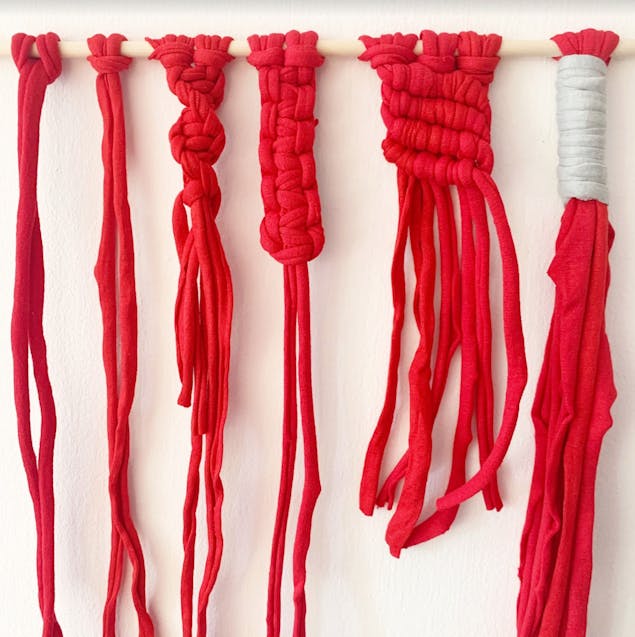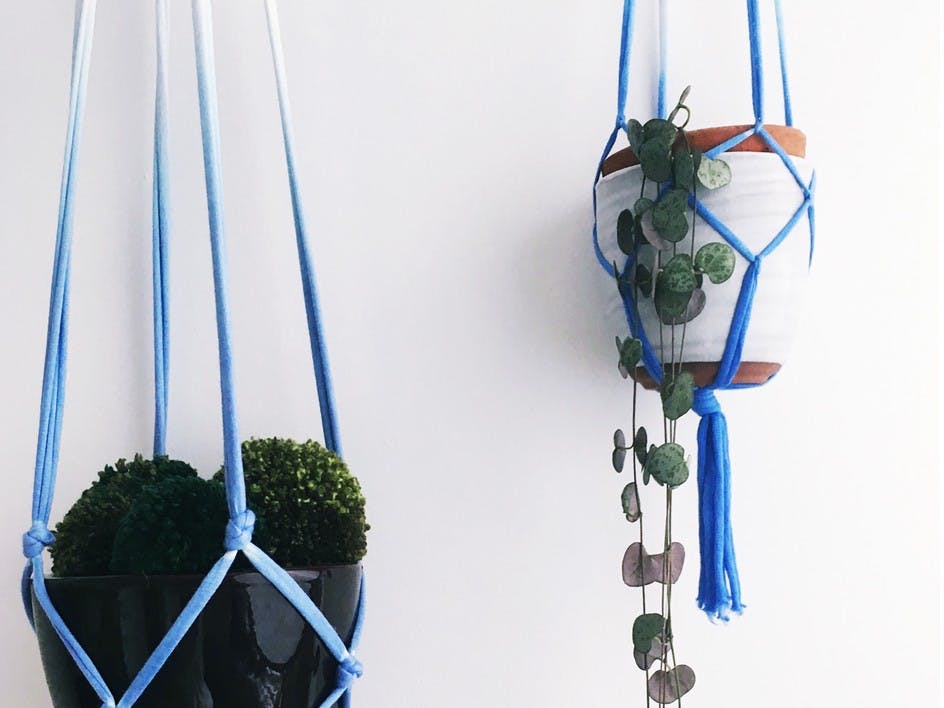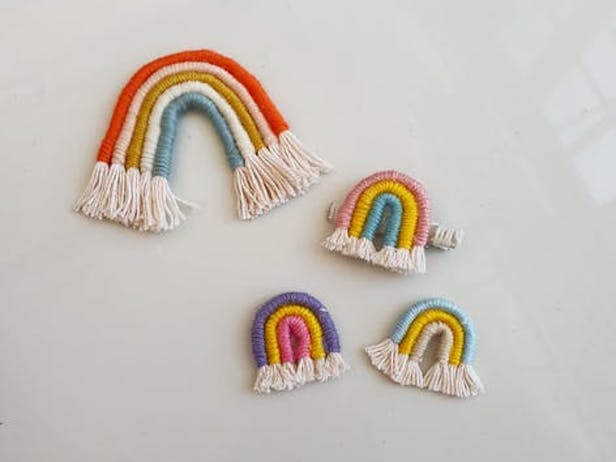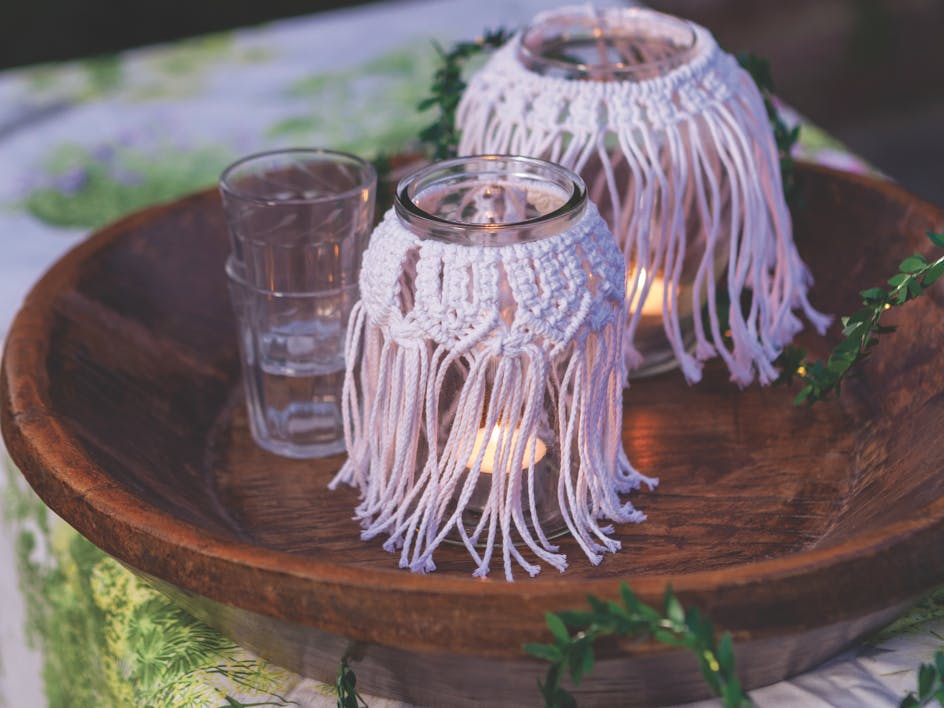What is macramé? Your ultimate guide
Published on June 4, 2020 3 min read
Become a master at macramé with these basic knots, you'll be creating macramé wall hangings and pretty plant holders in no time! Here's everything you need to know - from what macramé is to what macramé supplies and knots you need to know to create a masterpiece.
What is macramé?
Looking to learn how to make macramé? Look no further! Macramé is a super versatile textile art where you can use different knots to create everything from plant hangers, to wall art! Macramé is the name given to the fabric that's created by making a series of knots using different knotting techniques.
Using simple materials like cotton twine, hemp or different kinds of yarn you can create amazing textured homewares and unique accessories with macramé.
Macramé supplies
You don't need many specialist supplies or equipment to get started with macramé, but there are a few things you do need:
- Scissors
- Recycled cotton yarn (we love Paintbox Recycled Cotton Worsted)
- Recycled t-shirt yarn (we love Paintbox Recycled T-shirt yarn)
- A wooden dowel, a bamboo stick or something similar

Macramé knots
There are so many different knots you can use to create beautiful macramé makes. From the lark's head knot to the clove hitch knot, we've got a series of step-by-step guides to help you get started!
Lark’s head knot
The lark's head knot is used to attach your cord onto something such as a wooden dowel or cord etc so that you can then work with the lengths of cord to create beautiful knots.
1
Start with your cords ready to knot.
2
Take the 2 ends and thread under your stick.
3
Bring the 2 ends through and under the folded end of your cord and simply pull the ends down so the knot tightens up and sits under your stick.
4
Complete on all your cord lengths.
Reverse lark’s head knot
Same, same, but different.
1
Start with your cords ready to knot.
2
Take the folded end and place under your stick or holding cord.
3
Bring the 2 ends over your holding cord and under the folded edge. Pull through tightly.
4
Here is a comparison between the two knots: Left = reverse lark's head knot. Right = lark's head knot
Half square or spiral knot
Half square or spiral knot is perfect for wall hangings and hanging planters. You'll start with 2 sets of lark's head knot so you have 4 lengths of cord. You will notice you have two outer cords: a left outer cord and a right outer cord and 2 middle cords (known as filler cords). Remember these; as we refer to the left and right outer cords in this tutorial.
1
Take your left cord and place it over the 2 middle cords and under the right cord.
2
Take the end of the right outer cord and take it under the two middle cords and up through that gap created by the left cord.
3
Now pull both ends away from each and bring the knot up.
4
It should sit under your lark's head knot or holding cord/dowel.
5
Repeat: Take your left cord and place it over the 2 middle cords and under the right cord.
6
Take the end of the right outer cord and take it under the two middle cords and up through that gap created by the left cord.
7
Now pull both ends away from each and bring the knot up so it sits under the previous knot.
8
Continue repeating steps 5 to 7 and you will notice your knots spiral around.
Square knot
A square knot is a decorative knot used in most macramé projects. It sits flat and flush to its surface. Similar to the start of the half square knot, you'll start with 2 sets of lark's head knot so you have 4 lengths of cord.
1
Take your left cord and place it over the 2 middle cords and under the right cord.
2
Take the end of the right outer cord and bring it under the two middle cords and up through that gap created by the left cord. Pull those ends away from each other so the knot rests under your holding cord/dowel.
3
Next you need to reverse what you have just done. So now the right outer cord is placed over the 2 middle cords, and under the left outer cord.
4
Take the left outer cord and bring that under the two middle cords and up through the gap created by the right cord.
5
Now pull both ends away from each and bring the knot up so it sits under the previous knot.
6
Continue repeating steps 1 to 4 and you will notice your knots sit beautifully flat and create a really lovely pattern.
Gathering knot
This knot, commonly used for plant hangers and tassels, is an ideal a way of neatly wrapping all your cords and keeping them held together.
1
Grab and pinch your cords together where you would like the gathering knot to start.
2
Take a new piece of cord – approximately 50-60cm in length – and place it in position so that the tail end is facing up towards where you would like the gathering knot to start. We're using a different color so you can see what we're doing clearly, but you don't have to!
3
Fold the cord approximately four fingers in length back up to the starting point to create a loop and secure with your fingers where the two intersect. Now carefully wrap the cord (gray) around your group of cords (red).
4
Keep wrapping around the cords, each wrap neatly under the other. Stop before you get to the end of the loop – you need to leave a small loop so that you can thread the end of your wrapping cord through the loop as I have done in the image.
5
Now slowly pull the top tail end cord (this is the cord that is sticking out at the top of your gathering knot). As you pull this cord upwards you will notice that the little loop will start to move under the knot and soon it will disappear under the knot.
6
Once it's disappeared cut the excess cord from the top and bottom – this will leave you with a very neat gathering knot.
Clove hitch knot
The clove hitch knot can be knotted horizontally, vertically or diagonally depending on the look you are after. For this example, we’ve made a straight clove hitch knot. This can be used for making belts, bag straps, rugs, home accessories and wall hangings.
To get a diagonal or vertical clove hitch, you just need to change the angle of the filler cord. Here we’re doing half hitch knots – to make them into doubles you would simply repeat the wrap around with the same cord before moving onto the next cord.
1
The cord on the most left side will be your filler cord – this cord will be the same throughout the horizontal row. cord 2 then becomes your working cord. Take cord 2 and place it under the filler cord.
2
Now bring cord 2 up and over and around the filler cord as in the image.
3
Pull cord 2 and bring the clove hitch knot to the top and position it to the left.
4
Repeat steps 1 to 3 all the way across your row. I’ve placed cord 2 to the side now and will now use cord 3 to make a new wrap.
5
That is under the filler cord; and then up and over the filler cord.
6
Pull cord 3 and bring the clove hitch knot to the top and position it to the left next to the first clove hitch knot you made..
7
Continue using the next left cord (which is cord 4) and repeat the wrapping: cord goes under the filler, then cord goes up and over and around the filler cord. Then pull the working cord and neaten knot (in this case cord 4) and line it up next to the other 2 clove hitch knots.
8
Continue in this way repeating the wrap around over the filler cord until you have used up all your working cords.
9
To start a new row you create a new filler cord, this will be your left most cord. The new working cord goes under, then up and wraps around the filler cord and you continue in this manner.
10
And this is what it looks like when you have several rows of half clove hitch knots.
Now you know how to make macramé knots, you can use these six simple knots to create so many different things! With just a few supplies you can get busy making plant hangers, wall art, tote bags and so much more.







